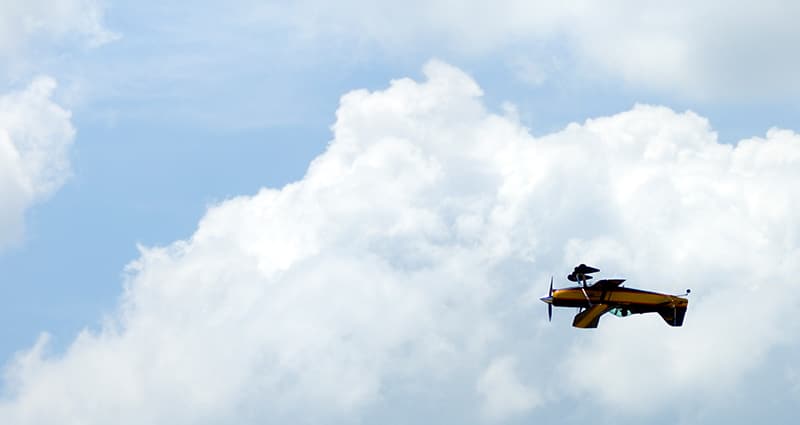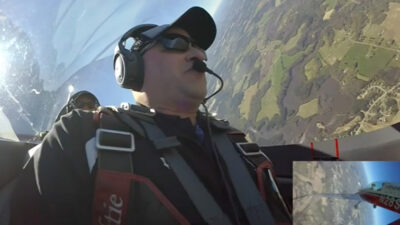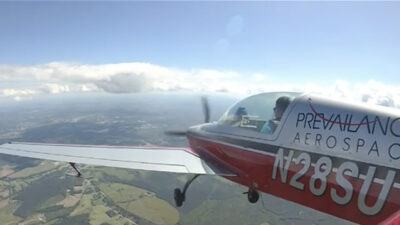Taking on Startle – One Flight at a Time!

In my first 13 years of flying, I faced little more than a dead battery. This past winter, however, I faced varied emergencies in multiple airplanes. The two that hold a special place in my memory include an electrical fire in an Embraer 170 and a flight control malfunction in a Pitts. As a trained Upset Prevention & Recovery Training (UPRT) instructor, I am certain that UPRT saved my life, and that of my passengers and crew, during these two events.
Responding to a Fire Emergency in a Chaotic Environment
During the first event, my day started like any other with a routine flight in the Embraer 170 from North Carolina to Massachusetts. We climbed to Flight Level 350 as we would any other day and were quickly alerted to fumes in the forward galley. We were 100 miles southwest of JFK with a fire somewhere aft of the cockpit.
We donned our oxygen masks, declared an emergency and began a divert to JFK. With the oxygen masks on, all communications transitioned from our headsets to two speakers in the cockpit. It was so hard to hear. I could hardly hear the captain or air traffic control. Additionally, we lost our displays momentarily as the Ram Air Turbine (RAT) deployed in the emergency descent from 4,000 to 2,000 feet over the ocean at the max speed of the aircraft.
What I realized after the fact was that the “surprises” that we create in UPRT are the same surprises that I faced on that flight. I also appreciated that my personal startle response was in full effect that day. Startle “is an involuntary physical reaction”1 and often leads to pilots freezing when faced with a surprise in the cockpit.
In my case, during the descent, I had to forget about the fire, the lack of communications, the noise and just focus on what I knew for sure – my flying abilities. My training gave me confidence. I was able to maintain a calm disposition despite the chaos around me. In spite of the rapid descent and multiple challenges enroute, our passengers made it safely to JFK and subsequently their final destination at BOS that night.
A Second Encounter With the Startle Effect
I also fly a Pitts Special in my off time from the regional airlines. A couple weeks after the aforementioned fire, I was flying at 1,500 feet in an aerobatic box when a left snap roll turned into a low altitude inverted maneuver. A snap roll is normally an accelerated stall and spin in the horizontal path, yet during this maneuver, when I pushed full left rudder, I heard a snap. I felt my right rudder slap forward and then spring back.
I thought that I had lost full rudder authority and was now in a left spin that I might not be able to recover normally, if at all. However, when I pressed the right rudder, it worked! I recovered low and inverted, pushed forward on the stick to break the AOA and rolled back upright without even thinking. This, too, was part of my training as a UPRT instructor. After landing, a pilot who witnessed the event said, “I’m just happy you didn’t pull after the snap roll that ended inverted.” Yes, I could have easily completed a half loop into the earth. Thankfully my training worked, and after landing I found out that the rudder cable was caught on the fuel cut off lever. Problem solved!
My upset training and instructing prepared me for both events. I remained calm and responded as each situation presented itself. I never gave up or stopped flying during these events. I always found a solution, even below 2,000 feet with a degraded airplane.
I recently read that “when an event produces a Startle Effect, if the first remedy applied does not produce an immediate and positive response to the situation, the mind may shut down and inaction follows.”2 I appreciate that my fight or flight response did not force me to freeze in the airplane. I credit that to my upset training and the muscle memory that saved me. UPRT prepares you for recoveries at all attitudes and develops the skills required to keep a calm disposition for any situation. I know it has already saved my life.
Resources
1 Startle Response, FAA, Retrieved from: https://www.faa.gov/news/safety_briefing/2016/media/MarApr2016.pdf.
2 Spitzmiller, Ted. Psychology of Pilot Responses. May 28, 2018. AVweb, Retrieved on 9/3/2019 from: https://www.avweb.com/flight-safety/technique/psychology-of-pilot-responses/.

Prevailance Aerospace is a UPRT provider that has been working with corporate, government, and general aviation pilots to improve safety in the aviation industry. Prevailance Aerospace uses Extra 300 Series Aircraft for training and our pilots are experienced aviation professionals from various military and general aviation backgrounds. We know that successful aviation endeavors are accomplished through an uncompromising commitment to safety, impeccable professionalism, tremendous attention to detail, and constant improvement.
http://prevailanceaerospace.com
© 2025 Prevailance Aerospace. All Rights Reserved.
Next ArticleRelated Posts

Rise Up for the Next Generation
There is no doubt in my mind that flying is the way mankind is meant to travel, yet the continued success and growth of the industry requires a refined approach to safety. As someone who flies commercially and with a new interest in a career in aviation, I want the reassurance that the pilot in command (PIC) and crew are adequately prepared if and when an aircraft ends up in an upset.

Three Considerations That Set Pilots Up for Success
Constantly reviewing aviation accidents and incidents is challenging. As an instructor, it is not only the injuries and fatalities that make it hard, but the sheer magnitude of avoidable aspects of each incident. These safety reports prove that every Pilot in Command (PIC) is accountable for what transpires.

